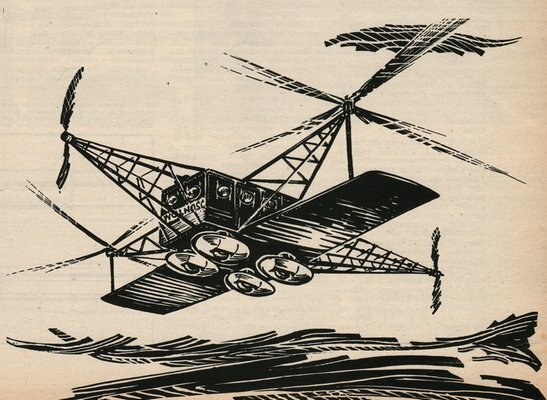- Joined
- 26 May 2006
- Messages
- 33,480
- Reaction score
- 13,527
Rotodyne helicopter Project. Poland / Austria-Hungary,
In the years 1895-1902 Jan Szczepanik conducted experiments with the models of rotodine helicopter he built. In 1902, he developed an aircraft design ("Aeromobile"), the idea of which was used in literary terms by Ludwik Szczepański in the novel King of the Air. A novel from the near future (1908) and The Revolution. A novel from the near future (1911). Both works belong to the popular trend of military novels predicting the rapid liberation of Poland and the outbreak of World War II. The protagonist of the books is the engineer Jan Silnicki, the inventor of an aircraft, an airmobile called Wolność, which will prove to be a tender object in the fight against Prussia and will open the way for the Allies to their capital. The fate of an extraordinary ship transformed into an aerial battleship, shown against the backdrop of the theater of warfare and the hero's love affairs, constitute the proper content of the books.
It was to be a rotodine helicopter, two-rotor, with counter-rotating rotors, 13 m in diameter, supported in flight by two fixed support planes. The fuselage was provided with a wheeled chassis and the engines were placed in the nacelle. The drive was carried out by an internal combustion engine. Apart from it, the camera had several electric motors powered by batteries. These were to be engines developed by Szczepanik, and ensuring the flight in 4-6 hours. The batteries could be recharged during the flight with solar energy on the basis of thermoelectricity. For horizontal flight, two propellers were placed at the front and rear of the camera (one each). Propellers diameter 5.0 m. Combustion engine power 110 kW (150 HP), propellers at 400 rpm. The length of the helicopter was to reach 15.0 m, total weight 2 tons, lifting capacity 500-1000 kg, flight speed 120 km / h.
The rotors were to be driven by electric motors. Stability was achieved by the low center of gravity. The rotor was also supposed to provide it. By changing the number of revolutions, the rotors were able to rebalance automatically. The construction material of the aircraft was steel pipes, bamboo and aluminum. Its structure was to be openwork. The cabin is similar to a railway car, made of aluminum sheets. The base is equipped with a type of bumpers-shock absorbers. On the front wall, the name Freedom is written in white and red letters.
In the years 1895-1902 Jan Szczepanik conducted experiments with the models of rotodine helicopter he built. In 1902, he developed an aircraft design ("Aeromobile"), the idea of which was used in literary terms by Ludwik Szczepański in the novel King of the Air. A novel from the near future (1908) and The Revolution. A novel from the near future (1911). Both works belong to the popular trend of military novels predicting the rapid liberation of Poland and the outbreak of World War II. The protagonist of the books is the engineer Jan Silnicki, the inventor of an aircraft, an airmobile called Wolność, which will prove to be a tender object in the fight against Prussia and will open the way for the Allies to their capital. The fate of an extraordinary ship transformed into an aerial battleship, shown against the backdrop of the theater of warfare and the hero's love affairs, constitute the proper content of the books.
It was to be a rotodine helicopter, two-rotor, with counter-rotating rotors, 13 m in diameter, supported in flight by two fixed support planes. The fuselage was provided with a wheeled chassis and the engines were placed in the nacelle. The drive was carried out by an internal combustion engine. Apart from it, the camera had several electric motors powered by batteries. These were to be engines developed by Szczepanik, and ensuring the flight in 4-6 hours. The batteries could be recharged during the flight with solar energy on the basis of thermoelectricity. For horizontal flight, two propellers were placed at the front and rear of the camera (one each). Propellers diameter 5.0 m. Combustion engine power 110 kW (150 HP), propellers at 400 rpm. The length of the helicopter was to reach 15.0 m, total weight 2 tons, lifting capacity 500-1000 kg, flight speed 120 km / h.
The rotors were to be driven by electric motors. Stability was achieved by the low center of gravity. The rotor was also supposed to provide it. By changing the number of revolutions, the rotors were able to rebalance automatically. The construction material of the aircraft was steel pipes, bamboo and aluminum. Its structure was to be openwork. The cabin is similar to a railway car, made of aluminum sheets. The base is equipped with a type of bumpers-shock absorbers. On the front wall, the name Freedom is written in white and red letters.

